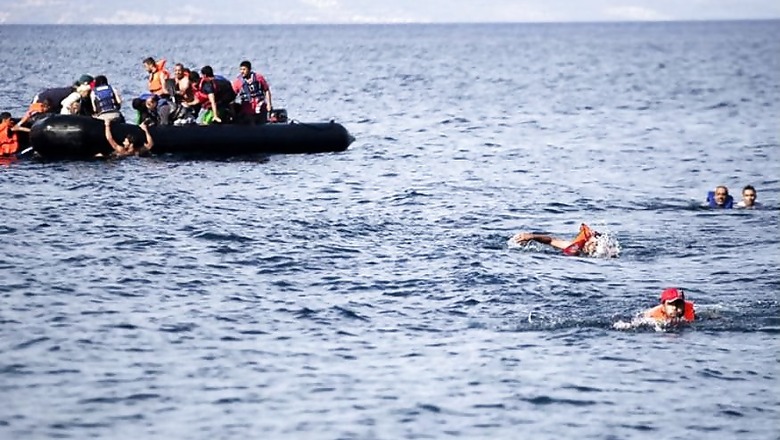
views
Brussels: New legal action by the EU against eastern member states for refusing to take their share of refugees shows how the worst migration crisis since World War II still divides the continent.
The images from a crisis entering its third year have become shockingly familiar: capsized boats, refugees teargassed in squalid border camps, a Syrian boy's tiny body on an empty beach.
Here AFP looks at the numbers that tell a deeper story. The basic facts are stark: Since 2014, more than 1.6 million people have arrived in Europe by sea while 13,500 have died on the way.
The migration crisis has no official starting point but statistics from the International Organization of Migration (IOM) offer some chronological yardsticks.
Following gradual yearly increases since 2011, 2014 marked a first turning point with 1,70,100 people landing on Italian shores and 43,518 on Greek coastlines, up from 42,900 and 11,447 respectively the previous year.
But it was in 2015 that the situation took on dizzying proportions. The IOM registered 1,011,712 arrivals by sea in Europe, including 853,650 on Greek shores, with the peak in arrivals hit in October, and 153,842 on Italy's coastline.
Among the arrivals in Greece in 2015, more than half -- 56.l per cent -- were Syrian, while 24.3 per cent were from Afghanistan and 10.3 per cent were from Iraq.
Most came to Greece across the Aegean Sea from Turkey. While the EU struggled to forge a collective response and
help Greece cope with the influx, most of the migrants trekked along the so-called Balkan route toward wealthy northern
European countries like Germany and Sweden.
The arrivals on the Italian coast in 2015 came on the central Mediterranean route, mainly from sub-Saharan African countries: 39,162 Eritreans, 22,237 Nigerians, 12,433 Somalis and 8,932 Sudanese.
There was a sharp drop in migrant arrivals in Greece in 2016, with the IOM registering a total of 363,401 arrivals on
Greek and Italian shores, about one-third as many as the previous year.
In Greece, 173,614 arrived by sea, a drop of nearly 80 percent, reflecting the combined impact of a controversial migrant deal between Turkey and the EU and the nearly total closure of the Balkans route.
The trend is continuing in 2017, with just 7,699 arrivals registered by the IOM in Greece during the first five months of the year.
But the lull in Aegean crossings is tenuous as Turkey is increasingly at odds with the EU and has threatened to scrap
the migrant deal over European criticism of its crackdown after an attempted coup against President Recep Tayyip Erdogan.
Italy meanwhile has seen arrivals continue apace, hitting a new record in 2016 with 181,436.
So far this year, figures confirm that the central Mediterranean route has once again become, by far, the main channel to Europe.
Italy has registered more than 65,000 arrivals since January, up nearly 20 per cent from the same period last year.
While the migration crisis is often portrayed as a crisis facing the EU's roughly 510 million people, smaller countries
outside the region have received a far higher proportion of arrivals.
Turkey hosts 3.2 million refugees, Lebanon shelters more than one million and Jordan is home to 660,000 according to
the UN High Commissioner for Refugees. The vast majority are Syrians.
Behind the migrant influx are human dramas. In total, nearly 14,000 people have died or disappeared trying to reach Europe in the last four years: 3,283 in 2014, 3,784 in 2015, 5,098 in 2016 and already more than 1,800 since January 1.
Moreover, among the asylum seekers in the EU in 2015 and2016, around a third were minors, according to the European
Commission.
The EU police agency Europol said in January last year that more than 10,000 unaccompanied migrant children had disappeared in Europe during the preceding 18 to 24 months, adding that many may have been victims of sexual abuse and
other assaults by organised crime networks.
EU countries had a record number of asylum applications in 2015, with nearly 1.26 million applying for the first time,
after 562,000 in 2014, according to Eurostat. These amount to the total requests in member states, which can include people who applied in several countries.
In 2016, EU countries granted protection to about 710,400 people, more than twice the figure of 2015, according to
Eurostat.
Some 55 per cent of the total in 2016 were listed as refugees, while 37 per cent were placed in the category of "subsidiary protection," or those who fall short of the criteria for refugee status but who are in danger in their home countries. Another eight per cent qualified for "authorisation to stay for humanitarian reasons".
Germany topped the EU in granting protection to the greatest number of people last year, with Eurostat reporting 445,210 positive decisions, or three times more than in 2015.
Much further behind were Sweden, with 69,350 positive decisions, Italy (35,450), France (35,170) and Austria (31,750). Syrians topped the list of people benefitting from protection in EU countries last year at 405,600, or 57 per cent of the total, ahead of Iraqis (65,800) and Afghans (61,800).
The rate of positive responses to asylum requests for one of the three statuses stood at 61 per cent on first request, and 17 per cent on appeal, but there were wide disparities depending on the nationality of the applicant.
The rates rose to 98.1 per cent on average for Syrians, 92.5 per cent for Eritreans and 63.5 per cent for Iraqis. The rate was far lower for other nationalities, like 17.4 per cent for Pakistanis, 5.2 per cent for Algerians and 3.1 per cent for Albanians.
Asylum seekers whose applications are rejected are supposed to be sent back to their country of origin, as are new arrivals who do not ask for asylum and are considered economic migrants.
About 305,365 people last year received an administrative or judicial order to return to their home country, up from 286,725 in 2015 and 251,986 in 2014, according to Frontex.
And 176,223 people were effectively deported in 2016, including 79,608 via a forced departure, Frontex said. Topping the list for forced departures were Albanians at 19,482, Moroccans at 7,506 and Kosovars at 4,916. Ukrainians, Iraqis and Indians topped the category of people who chose to leave voluntarily.




















Comments
0 comment